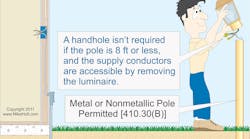Q. What are the NEC rules regarding poles used to support luminaires?
Find the Answer
A. A pole can be used to support luminaires and serve as a raceway [410.30]. However, they must comply with the following six requirements:
1) The pole must have an accessible 2 in. x 4 in. handhole with a cover suitable for use in wet locations that provides access to the supply conductors within the pole. There are two exceptions to this rule.
Exception No. 1: The handhole isn’t required for a pole that’s 8 ft or less in height, if the supply conductors for the luminaire are accessible by removing the luminaire (see Figure).
Exception No. 2: The handhole can be omitted on poles that are 20 ft or less in height, if the pole is provided with a hinged base.
2) When the supply raceway or cable doesn’t enter the pole, a threaded fitting or nipple must be welded, brazed, or attached to the pole opposite the handhole opening for the supply conductors.
3) A metal pole must have an equipment grounding terminal accessible from the handhole.
Exception: A grounding terminal isn’t required in a pole that’s 8 ft or less in height above grade if the splices are accessible by removing the luminaire.
4) A metal pole with a hinged base shall have the hinged base and pole bonded together.
5) Metal poles used for the support of luminaires must be connected to an equipment grounding conductor of a type recognized in 250.118 [250.4(A)(5)].
DANGER: Because the contact resistance of an electrode to the earth is so high, very little fault current returns to the power supply if the earth is the only fault current return path. Result — the circuit overcurrent device won’t open and clear the ground fault, and the metal pole will become and remain energized by the circuit voltage.
6) Conductors in vertical metal poles must be supported when the vertical rise exceeds 100 ft [Table 300.19(A)]. Note: When provided by the manufacturer of roadway lighting poles, so-called J-hooks must be used to support conductors, as they’re part of the listing instructions [110.3(B)].
With security being a high priority, many owners want to install security cameras on existing parking lot poles. However, 820.133(A)(1)(b) prohibits the mixing of power and communications conductors in the same raceway.





